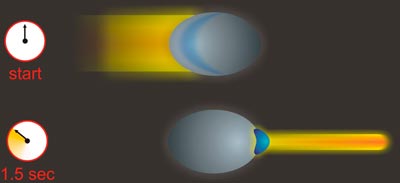Dec 15, 2009
Source:http://physicsworld.com/cws/article/news/2009/dec/15/slowed-light-breaks-record

Easy does it: light clocked at 25 km/h
Kilometre-long pulses of light have been stored for over one second in a 0.1 mm cloud of ultracold atoms – before being revived and sent on their way. This latest demonstration of light storage using electromagnetically induced transparency (EIT) is the first to break the second barrier using ultracold atoms and has the added bonus of preserving the quantum state of the incoming pulse. The physicists in the US who carried out the experiment say that the work could play a key role in quantum information technology.
EIT is a phenomenon in which certain media that do not usually transmit light at a certain wavelength can be made transparent by applying light at a slightly different wavelength. EIT can be used to slow down a pulse of light so that it could effectively be "stored" in a medium. The first person to see EIT in an atom cloud was Stephen Harris at Stanford University in 1991, and he went on to slow light by a factor of 100 in 1995. Then in 1999, Lene Hau and team at Harvard University managed to slow light by a factor of 30 million. They used a Bose–Einstein condensate (BEC), which is a gas of atoms that is so cold that all the atoms settle into a coherent quantum state.
Now Hau and team have used a BEC of sodium to store light for over one second. The atoms were chosen because they have a specific configuration of three energy levels. Transitions between the two lowest levels (1 and 2) are forbidden – but transitions can occur between either 1 or 2 and the highest-energy level (3).
Interfering transitions
The experiment begins with the atoms in state 1 and illuminated with a "coupling" laser with a wavelength that matches the 2–3 transition. The pulse to be stored – called the "probe" – is then fired into the BEC. If there were no coupling laser, the pulse would be absorbed by exciting transitions from levels 1 to 3. However the coupling laser also excites transitions from levels 2 to 3 – and these two transitions interfere with each other.
When the coupling laser is switched off, this interference leaves an "imprint" of the pulse within atoms in level 2. The coupling laser is then switched back on and the level 2 atoms are excited up to level 3, before dropping down to level 1 by emitting a pulse of light at the probe wavelength. This pulse is identical to the original probe pulse – at least in principle – because its quantum nature was stored in level 2 atoms in the BEC.
The challenge for Hau and colleagues was to minimize interactions between imprint atoms and the BEC to ensure that the imprint endured for as long as possible. To do this, the team applies a magnetic field to the BEC, which causes the atoms to phase-separate according to energy state. As a result, the portion of the BEC that is storing the pulse separates from the rest of the BEC like a drop of oil moving through water.
Slowed to 25 km/h
Although this separation process involves distorting the pulse-storing BEC – and hence the nature of the revived pulse – it is completely deterministic, which means that no quantum information is lost. By doing so, the team was able to store the pulse for up to about 1.5 s, shattering the previous record of about 600 ms. Furthermore, the fidelity of the revived pulse – the ratio of output energy to input energy – was more that 100 times better than previous systems.
Another remarkable aspect of the experiment is that the probe pulse – which is about 1 km long in air – is compressed to a drop just 20 µm in length as it travels through the BEC at about 25 km/h.
One possible application for the system is a "quantum repeater", which would allow pairs of entangled photon states to be separated by more than the 100 km or so that is now possible using optical fibres. Under this scheme, a succession of pairs of atom clouds, separated by short distance and storing entangled photons, could be manipulated and combined to extend the stored photon entanglement over long distances. This capability could be important for developing quantum cryptography systems.
Hau told physicsworld.com that the technique could be adapted to process the information contained in the pulse. For example, the drop could be split into two before revival – which would create two entangled pulses of light. Another option, according to Hau, is that only one of the drops is revived – creating a pulse of light that is entangled with the remaining atoms. Another possibility is the creation of "squeezed" light pulses, in which the number of photons in the pulse is set by the number of atoms in the BEC.
According to Hau, the storage time could be increased to as long as 5 s by boosting the stability of the magnetic field used to separate the BEC. However, she also points out that the lifetime is ultimately limited by the tendency of the atoms to join together to form metallic molecules.
The work is reported in Physical Review Letters.
